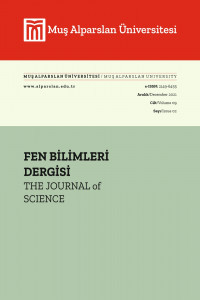Yeni Bir Tahribatsız Muayene Yöntemi: Bakteri Kültürüyle Mikro Hata Tespiti
Mikro boyutta üretim bilimsel, teknolojik ve endüstriyel alanlarda oldukça önemli bir yer tutmaktadır. Hali hazırda kullanılan tahribatsız muayene yöntemleri bu tip mikro hataların tespitinde yetersiz kalmaktadır. Makalede açıklanan yeni teknikle bakteri hücreleri, incelenmek istenen yüzeye uygulanarak yüzeye açık olan mikro boyuttaki yarıklar, çatlaklar ve boşluklar tespit edilebilmektedir. Bu tekniğin temelini bakterilerin oldukça küçük boyutları, yüksek penetrasyon kapasiteleri, hareket edebilirlikleri, tutunabilirlikleri, floresans özellikleri, elektrik ve manyetik alana duyarlılıkları ve tekrar üretilebilir olmaları gibi özellikleri oluşturmaktadır.
Anahtar Kelimeler:
Bakteri Kültürü, Mikro Hata, Tahribatsız Muayene
New Non-Destructive Test: Micro Defect Detection by Bacterial Cell
Micro production is crucial for scientific, technologic and industrial areas. As used non-destructive testing methods are insufficient for determining these kinds of micro defects. With this new technique micro defects on surface like fissures, cracks and voids could be determined by applying bacterial cells on the surface to be examined. The considerably small dimensions, high penetration abilities, mobilities, adhesive properties, fluorescence properties, sensitivities to magnetic and electric field and reproducibility of bacterial cells create the base of this technique.
Keywords:
Bacterial cell, micro defect, non-destructive technique,
___
- Santos T.G., Inacio P.L., Costa A.A., Miranda R.M., De Carvalho C.C.C.R. Applications of a new NDT technique based on bacterial cells, 19th World Conference on Non-Destructive Testing, Munich, Germany, 2016.
- Ferreira T.J., Farinha A.R., Santos T.G., Miranda R., Carvalho C.C.C.R., Vieira M.T. Nondestructive testing in microfabrication using bacteria, Ciencia & Tecnologia dos Materiais, 29, 262-264, 2017.
- Carvalho C.C.C.R., Inacio P.L., Miranda R.M., Santos T.G. Using Biotechnology to Solve Engineering Problems: Non-Destructive Testing of Microfabrication Components, Materials, 10, 788, 2017.
- Ghoni R., Dollah M., Sulaiman A., Ibrahim F.M. Defect characterization based on eddy current technique: Technical review, Advances in Mechanical Engineering, 6, 182496, 2014.
- Abdelhamid M., Singh R., Omar M. Review of microcrack detection techniques for silicon solar cells, IEEE Journal of Photovoltaics, 4, 514–524, 2014.
- Ibrahim M.E. Nondestructive evaluation of thick-section composites and sandwich structures: A review, Composites Part A: Applied Science and Manufacturing, 64, 36–48, 2014.
- Jolly M.R., Prabhakar A., Sturzu B., Hollstein K., Singh,R., Thomas S., Foote P., Shaw A. Review of non-destructive testing (NDT) techniques and their applicability to thick walled composites, Procedica CIRP, 38, 129–136, 2015.
- McMaster R.C. Nondestructive Testing Handbook: Liquid Penetrant Tests, 2nd ed.; American Society for Nondestructive Testing, 1982, USA.
- Eisenmann D.J., Enyart D., Lo C., Brasche L. Review of progress in magnetic particle inspection. AIP Conference Proceedings, 1581, 1505–1510, 2014.
- Santos T.G., Miranda R.M., Carvalho C.C.C.R. A new NDT technique based on bacterial cells to detect micro surface defects, NDT&E International, 63, 43-49, 2014.
- Ceyhan İ. Biyogüvenlik Laboratuvar Seviyeleri ve Biyogüvenlik Kabinlerinin Seçimi Kullanımı ve Bakımı, 4. Ulusal Sterilizasyon Dezenfeksiyon Kongresi, Samsun, 2005.
- Richardson J., Barkley W., Richmond D., Mckinney R. Biosafety in Microbiological and Biomedical Laboratories, U.S. Department of Health and Human Services, Public Health Service, Centers for Disease Control and Prevention, National Institutes of Health, 2011, USA.
- Santos T.G., Miranda R.M., Vieira M.T., Farinha A.R., Ferreira T.J., Quintino L., Vilaça P., Carvalho C.C.C.R. Developments in micro- and nano-defects detection using bacterial cells, NDT&E International, 78, 20-28, 2016.
- ISSN: 2147-7930
- Yayın Aralığı: Yılda 2 Sayı
- Başlangıç: 2013
- Yayıncı: Muş Alparslan Üniversitesi
Sayıdaki Diğer Makaleler
Yeni Bir Tahribatsız Muayene Yöntemi: Bakteri Kültürüyle Mikro Hata Tespiti
Hülya DURMUŞ, Bahar Şölen AKDEMİR
Canser GÜL, Sevda ALBAYRAK, Hülya DURMUŞ
Ortam Şartlarının Bir Haptik-Teleoperasyon Sisteminin İki-Yönlü Kontrolü Üzerindeki Etkisi
Kafes Normlu Riesz Cebirleri Üzerindeki Operatörler İçin Hahn-Banach Teoremi
